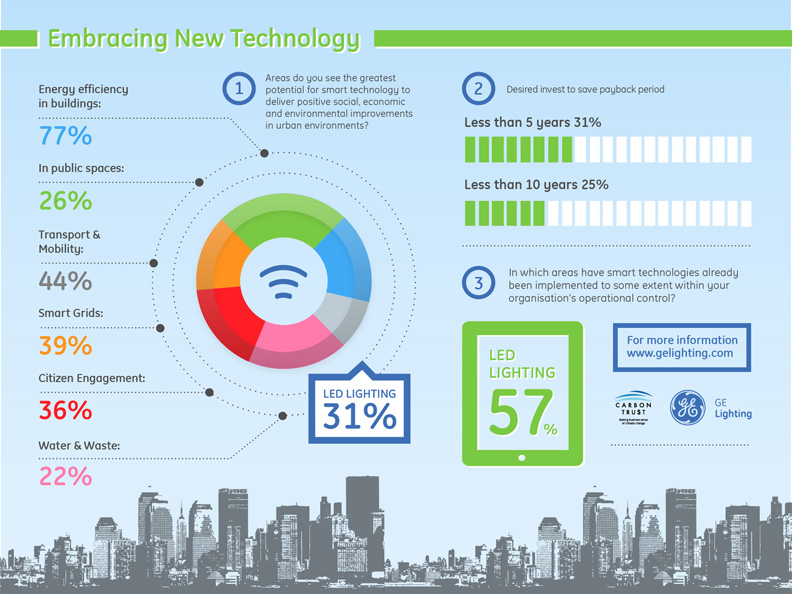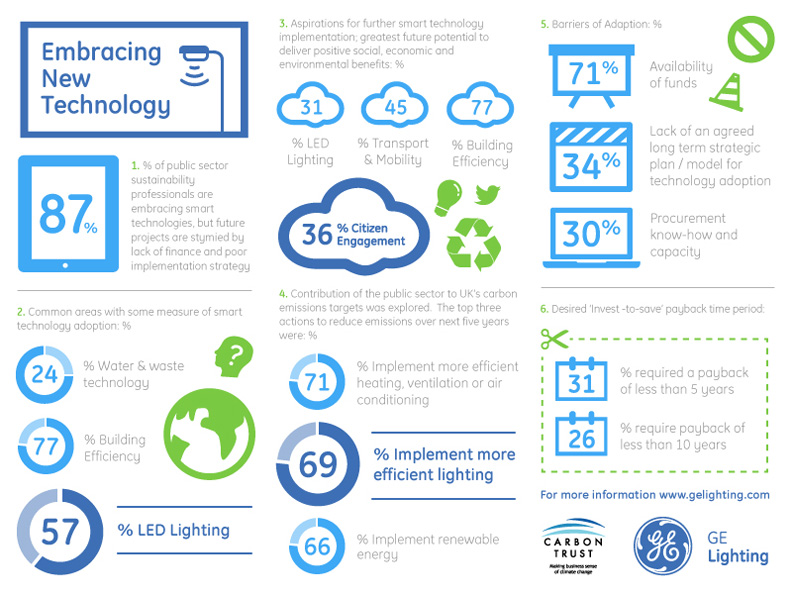Embracing new technology- New research by GE Lighting and the Carbon Trust finds that most UK public bodies have begun to adopt intelligent technologies, in order to drive social, economic and environmental benefits within their estates.
87% of public sector sustainability professionals have begun to embrace smart technologies, but future projects are stymied by lack of finance and poor implementation strategy
New research by GE Lighting and the Carbon Trust finds that most public bodies have begun to adopt intelligent technologies, in order to drive social, economic and environmental benefits within their estates.
 |
|
GE and the Carbon Trust findings on smart technology adoptions in building efficiency, LED lighting, water and waste technologies. (Source: GE) |
The most common areas where there has been some measure of smart technology adoption are building efficiency (77%), LED lighting (57%) and water and waste technologies (24%). The smart technologies respondents have installed include intelligent features, such as sensors, which combined with internet connectivity and control systems, enhance performance and efficiency and reduce resource consumption, costs and carbon emissions.
The public sector is realising the potential of smart technologies for delivering public services cost efficiently and intelligently. However, executives face clear challenges, due to budget cuts, as well as the lack of clear long term implementation strategies. This can often lead to a “lock-in effect”, leaving estates stuck with old, inefficient equipment that is more expensive over its life span.
Almost two thirds of the sample (64%) cited availability of funds as the biggest barrier to the implementation of smart technologies. This was despite the existence of self-financing models, such as Special Purpose Vehicles (SPVs), which many estates are employing to obtain capital. In addition, concessional finance available to the public sector such as the Public Works Loan Board, as well as the Green Investment Bank, provide options to get projects off the ground.
The other key barriers to adoption beyond finance included:
· Lack of an agreed long term strategic plan / model for technology adoption (34%)
· Procurement know-how and capacity (30%)
· Lack of internal ownership of smart technology projects (26%)
· Implementation risk in moving away from existing technology (22%)
The top three barriers - related to finance, organisational strategy, and procurement know-how can be addressed via enhanced communication and training, skills and internal support to help public sector employees understand how to build and procure investable projects. Without this skill set, adoption of smart, low carbon infrastructure in the public sector will be held back.
Agostino Renna, President and CEO of GE Lighting Europe, Middle East & Africa, said:
“Technology is no longer the key barrier for adoption of smart technologies, the barriers are now related to procurement and skills. The good news is that innovative business models exist, such as self-financing, allowing estates to de-risk procurement, prevent lock-in and benefit from major efficiencies, for example from intelligent lighting, which can cut energy bills by up to 80%.”
The survey also revealed aspirations for further smart technology implementation; with the following areas highlighted as having the greatest future potential to deliver positive social, economic and environmental benefits:
· Building efficiency (77%)
· Transport & Mobility (45%)
· Citizen engagement (36%)
· LED Lighting (31%)
· Energy efficiency in public spaces (27%)
Looking specifically at lighting, the research finds that nearly three quarters of the sustainability professionals surveyed (71%) are planning to invest in lighting systems within the next five years. The largest proportion of those planning to upgrade lighting (25%) planned to replace lamps using LEDs, plus to install control systems. There is clear value proposition to transition to LED and those who do it in the coming 2-3 years will have an available platform to implement smart city solutions.
Agostino Renna, added:
“Even with the large scale adoption of LED lighting currently within the public sector, executives recognise that with the sharp fall in costs over the last 18 months, lighting has one of the clearest business cases for further adoption. The beauty of LED control systems is that, since they are based on software, they need never become obsolete, since the software can simply be updated as technology advances, or the estate's needs change.”
The research was carried out by GE Lighting, in association with the Carbon Trust, and was completed by surveying 164 public sector sustainability professionals attending the recent Carbon Trust Public Sector Conference in the UK in February 2015. Respondents come from a range of operational and management roles within local authorities, NHS bodies, universities, emergency services, central government departments and housing associations.
The contribution of the public sector to the UK's carbon emissions targets was also explored in the research. The respondents were asked what action they were likely to take in key areas over the next five years to reduce carbon emissions. The top three responses were:
· Implement more efficient heating, ventilation or air conditioning (71%)
· Implement more efficient lighting (69%)
· Implement renewable energy (66%)
 |
|
(Source: GE) |
The research investigated the payback that “invest-to-save” carbon reduction projects would typically require. The payback periods required varied significantly between organisations:
· 31 % required a payback of less than 5 years, 26% require payback of less than 10 years
· 21% did not know the required payback
· 11% require less than a 3 year payback
· 8% answered that a payback of over 10 years is acceptable
Tim Pryce, Head of Public Sector at the Carbon Trust, said:
“A lot of carbon reduction projects can deliver very attractive paybacks through both operational and energy cost saving, but there are a number of barriers that prevent public sector bodies from moving forward. Public sector sustainability professionals need a mix of financial, procurement and project management skills to design and implement investable projects. This will help public bodies to build the business case for investing in technologies and equipment that can deliver real efficiency and carbon savings.”













